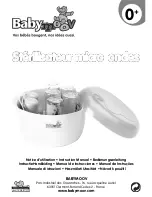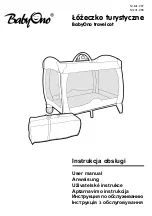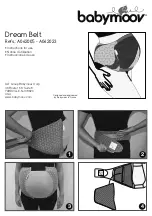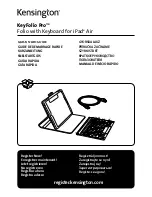
2 - SAFETY INFORMATION
Before you leave the machine:
1. Park the machine on a firm, level surface.
2. Put all controls in neutral or park lock position.
3. Engage the parking brake. Use wheel chocks if re-
quired.
4. Lower all hydraulic equipment - Implements, header,
etc.
5. Turn off the engine and remove the key.
When, due to exceptional circumstances, you would
decide to keep the engine running after you leave
the operator’s station, then you must follow these
precautions:
1. Bring the engine to low idle speed.
2. Disengage all drive systems.
3.
WARNING
Some components may continue to run down
after disengaging drive systems.
Make sure all drive systems are fully disen-
gaged.
Failure to comply could result in death or seri-
ous injury.
W0113A
Shift the transmission into neutral.
4. Apply the parking brake.
General maintenance safety
Keep the area used for servicing the machine clean and
dry. Clean up spilled fluids.
Service the machine on a firm, level surface.
Install guards and shields after you service the machine.
Close all access doors and install all panels after servicing
the machine.
Do not attempt to clean, lubricate, clear obstructions, or
make adjustments to the machine while it is in motion or
while the engine is running.
Always make sure that working area is clear of tools,
parts, other persons and pets before you start operating
the machine.
Unsupported hydraulic cylinders can lose pressure and
drop the equipment, causing a crushing hazard. Do not
leave equipment in a raised position while parked or dur-
ing service, unless the equipment is securely supported.
Jack or lift the machine only at jack or lift points indicated
in this manual.
Incorrect towing procedures can cause accidents. When
you tow a disabled machine follow the procedure in this
manual. Use only rigid tow bars.
Stop the engine, remove the key, and relieve pressure
before you connect or disconnect fluid lines.
Stop the engine and remove the key before you connect
or disconnect electrical connections.
Scalding can result from incorrect removal of coolant
caps.
Cooling systems operate under pressure.
Hot
coolant can spray out if you remove a cap while the sys-
tem is hot. Allow the system to cool before you remove
the cap. When you remove the cap, turn it slowly to allow
pressure to escape before you completely remove the
cap.
Replace damaged or worn tubes, hoses, electrical wiring,
etc.
The engine, transmission, exhaust components, and hy-
draulic lines may become hot during operation. Take care
when you service such components. Allow surfaces to
cool before you handle or disconnect hot components.
Wear protective equipment when appropriate.
When welding, follow the instructions in the manual. Al-
ways disconnect the battery before you weld on the ma-
chine. Always wash your hands after you handle battery
components.
Wheels and tires
Make sure that tires are correctly inflated. Do not exceed
any recommended load or pressure. Follow the instruc-
tions in the manual for proper tire inflation.
Tires are heavy. Handling tires without proper equipment
could cause death or serious injury.
Never weld on a wheel with a tire installed. Always re-
move the tire completely from the wheel prior to welding.
Always have a qualified tire technician service the tires
and wheels. If a tire has lost all pressure, take the tire and
wheel to a tire shop or your dealer for service. Explosive
separation of the tire can cause serious injury.
DO NOT weld to a wheel or rim until the tire is completely
removed. Inflated tires can generate a gas mixture with
the air that can be ignited by high temperatures from weld-
ing procedures performed on the wheel or rim. Removing
the air or loosening the tire on the rim (breaking the bead)
will NOT eliminate the hazard. This condition can exist
whether tires are inflated or deflated. The tire MUST be
completely removed from the wheel or rim prior to weld-
ing the wheel or rim.
2-3
Summary of Contents for 580ST
Page 8: ......
Page 24: ...1 GENERAL INFORMATION 1 16 ...
Page 49: ...2 SAFETY INFORMATION Extend telescopic dipper If fitted MOLI12LBB0092AA 24 2 25 ...
Page 101: ...3 CONTROLS AND INSTRUMENTS Setup menu LEIL12TLB00006I 1 3 39 ...
Page 144: ...3 CONTROLS AND INSTRUMENTS 3 82 ...
Page 164: ...4 OPERATING INSTRUCTIONS 4 20 ...
Page 166: ...5 TRANSPORT OPERATIONS RAIL14TLB1181GA 1 5 2 ...
Page 222: ...6 WORKING OPERATIONS 6 44 ...
Page 247: ...7 MAINTENANCE Fuel tank capacity 145 L 38 30 US gal 2WS 124 L 32 76 US gal 4WS 7 25 ...
Page 347: ...7 MAINTENANCE Fuses and relays Powershift cab 2WS MOLI12LBB0491CA 7 7 125 ...
Page 349: ...7 MAINTENANCE Fuses and relays Powershift cab 4WS MOLI12LBB0492CA 8 7 127 ...
Page 390: ...8 TROUBLESHOOTING 8 28 ...
Page 418: ...9 SPECIFICATIONS 4WS LEEN11T0039FA 2 9 28 ...
Page 420: ...9 SPECIFICATIONS 2WS 590ST LEEN11T0041FA 5 4WS 695ST LEEN11T0042FA 6 9 30 ...
Page 433: ......
















































